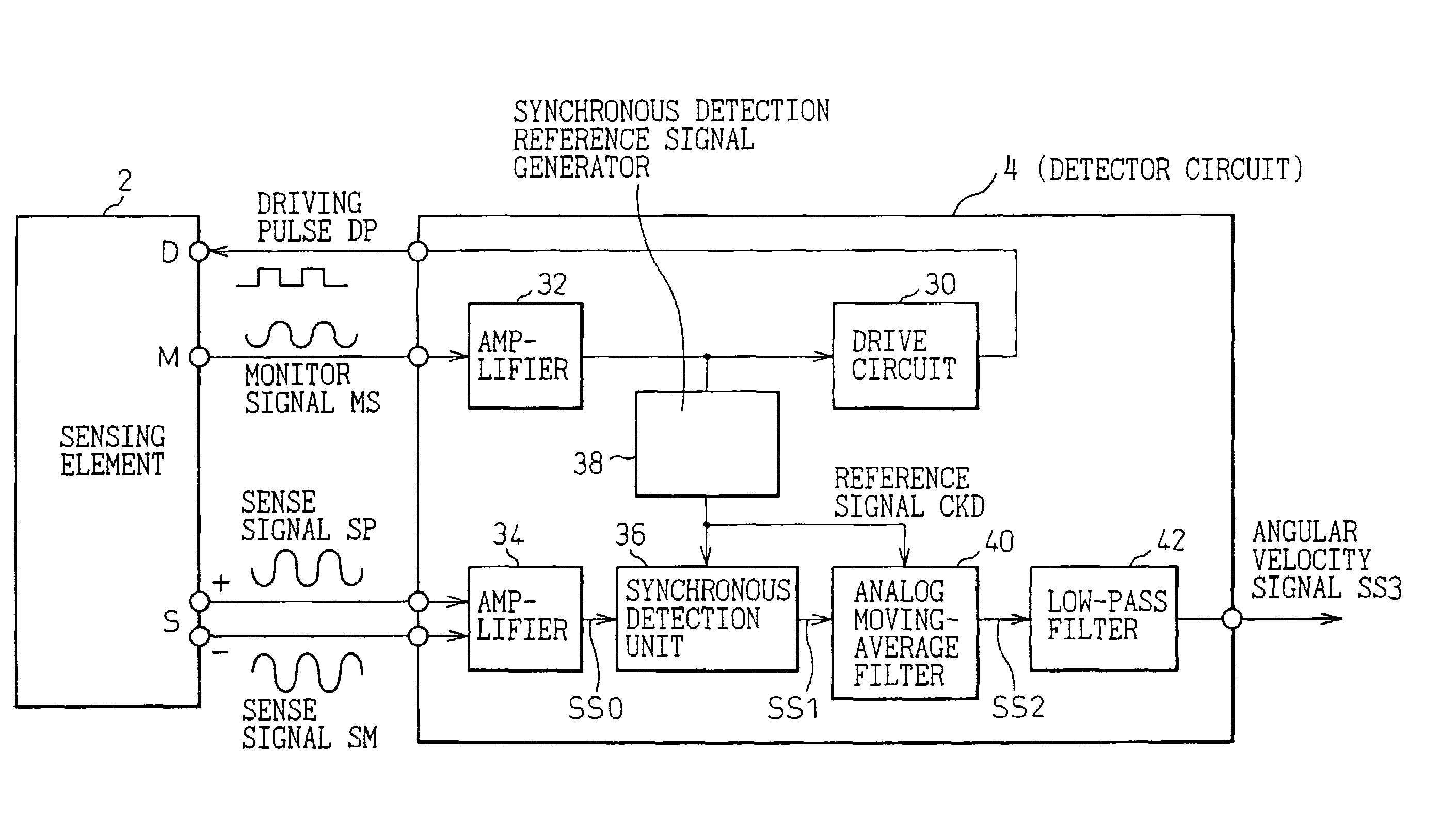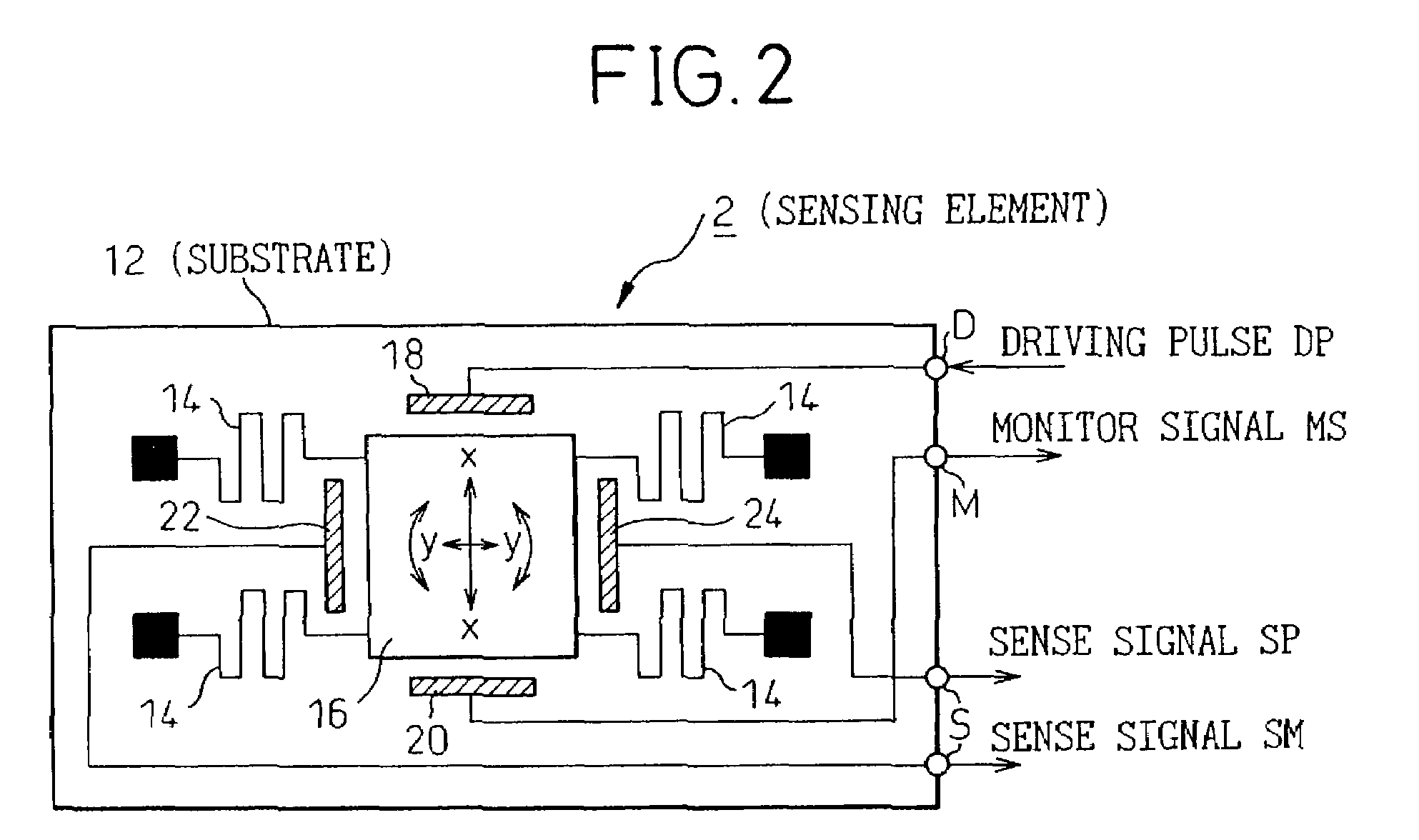Synchronous detection method and device, and sensor signal detector
- Summary
- Abstract
- Description
- Claims
- Application Information
AI Technical Summary
Benefits of technology
Problems solved by technology
Method used
Image
Examples
first embodiment
[0066]FIG. 1 is a block diagram showing the overall configuration of an angular velocity detector to which the first embodiment of the present invention is adapted.
[0067]The angular velocity detector of the present embodiment is a so-called vibratory gyroscope. The angular velocity detector consists of a sensing element 2 that is a vibrator, and a detector circuit 4 (corresponding to a sensor signal detector in accordance with the present invention) that drives the sensing element 2 and detects an angular velocity at which the angular displacement of the vibrator has changed due to an external factor.
[0068]The sensing element 2 has, for example, as shown in FIG. 2, a substantially rectangular vibrator 16 mounted on a substrate 12 made of a monocrystalline silicon or the like by way of four beams 14 extending from the corners of the substrate. A driving electrode 18, a monitor electrode 20, and a pair of detection electrodes 22 and 24 are disposed around the vibrator 16. The driving ...
second embodiment
[0092]FIG. 7 is a block diagram showing the overall configuration of an angular velocity detector to which the second embodiment is adapted.
[0093]The angular velocity detector to which the present embodiment is adapted has basically the same configuration as the angular velocity detector to which the first embodiment is adapted. Differences from the first embodiment will be described below. Namely, the vibrator 16 included in the sensing element 2 is vibrated with a driving signal that is produced by superposing a carrier CR on a driving pulse DP produced by the drive circuit 30. The frequency of the carrier CR is higher than the frequency of the driving pulse DP (for example, 1 MHz). Thus, the carrier CR is superposed on the sense signals SP and SM that are produced by the sensing element 2 (eventually, on the sense signal SS0 produced by the differential amplifier 34). The sense signal SS0 produced by the differential amplifier 34 is detected using the reference signal CKD synchro...
third embodiment
[0107]FIG. 10 is a block diagram showing the overall configuration of an angular velocity detector to which the third embodiment is adapted.
[0108]The angular velocity detector to which the present embodiment is adapted is basically identical to the one to which the first embodiment is adapted. Differences from the first embodiment will be described below. Namely, a time-domain analog-to-digital (A / D) converter with the capability of a filter 60 is included for realizing the capability of an analog moving-average filter. The temporal A / D converter with the capability of a filter 60 is used to produce an analog moving average of the detection signal SS1. The result of the production is A / D converted. Moreover, a digital moving average of digital data Da produced by the temporal A / D converter 60 is produced using a digital moving-average filter 80. Consequently, digital data DT is transmitted as the angular velocity signal SS3.
[0109]The foregoing differences will be described below.
[01...
PUM
 Login to View More
Login to View More Abstract
Description
Claims
Application Information
 Login to View More
Login to View More - R&D
- Intellectual Property
- Life Sciences
- Materials
- Tech Scout
- Unparalleled Data Quality
- Higher Quality Content
- 60% Fewer Hallucinations
Browse by: Latest US Patents, China's latest patents, Technical Efficacy Thesaurus, Application Domain, Technology Topic, Popular Technical Reports.
© 2025 PatSnap. All rights reserved.Legal|Privacy policy|Modern Slavery Act Transparency Statement|Sitemap|About US| Contact US: help@patsnap.com



